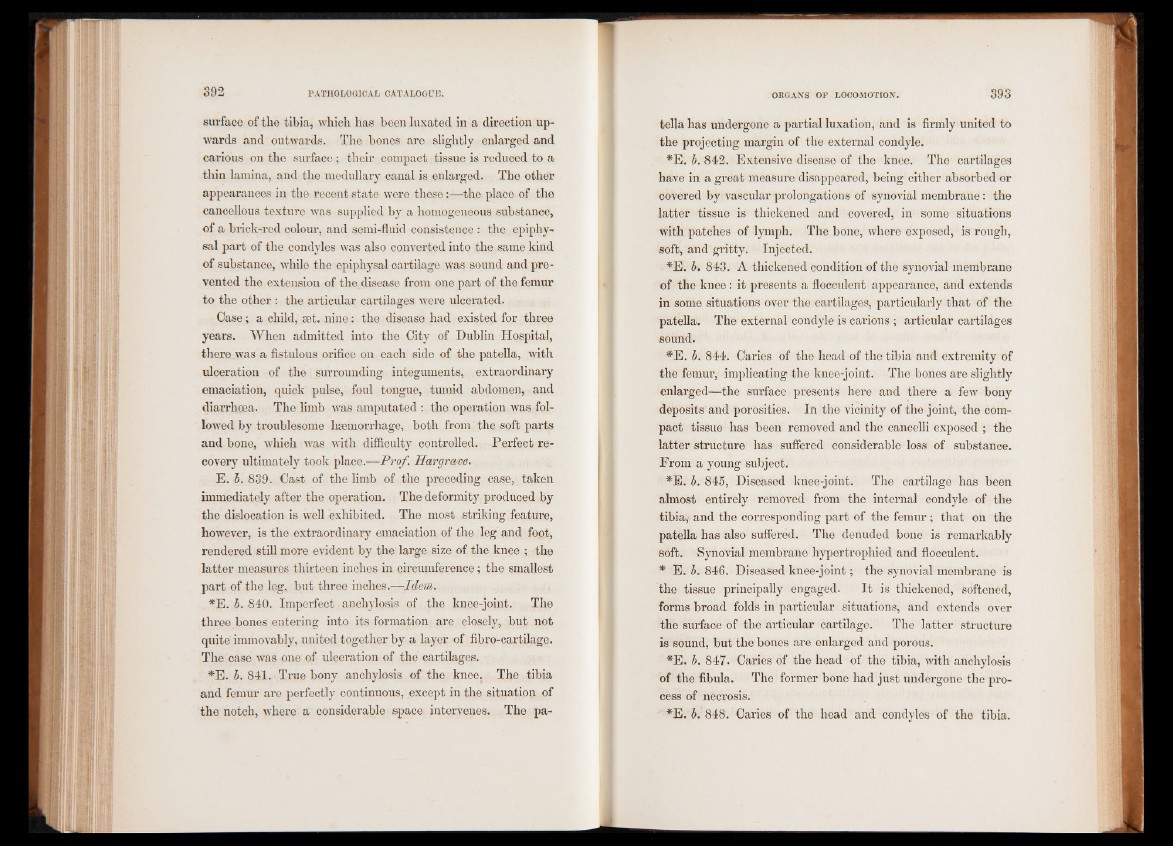
surface of the tibia, which has been luxated in a direction upwards
and outwards. The bones are slightly enlarged and
carious on the surface; their compact tissue is reduced to a
thin lamina, and the medullary canal is enlarged. The other
appearances in the recent state were these:—the place of the
cancellous texture was supplied by a homogeneous substance,
of a brick-red colour, and semi-fluid consistence : the epiphy-
sal part of the condyles was also converted into the same kind
of substance, while the epiphysal cartilage was sound and prevented
the extension of the disease from one part of the femur
to the other : the articular cartilages were ulcerated.
Case; a child, set. nine: the disease had existed for three
years. When admitted into the City of Dublin Hospital,
there was a fistulous orifice on each side of the patella, with
ulceration of the surrounding integuments, extraordinary
emaciation, quick pulse, foul tongue, tumid abdomen, and
diarrhoea. The limb was amputated : the operation was followed
by troublesome haemorrhage, both from the soft parts
and bone, which was with difficulty controlled. Perfect recovery
ultimately took place.—Prof. Hargrave.
E. b. 839. Cast of the limb of the preceding case, taken
immediately after the operation. The deformity produced by
the dislocation is well exhibited. The most striking feature,
however, is the extraordinary emaciation of the leg and foot,
rendered still more evident by the large size of the knee ; the
latter measures thirteen inches in circumference; the smallest
part of the leg, but three inches.—Idem.
*E. b. 840. Imperfect anchylosis of the knee-joint. The
three bones entering; into its formation are closely, but not
quite immovably, united together by a layer of fibro-cartilage.
The case was one of ulceration of the cartilages.
*E. b. 841. True bony anchylosis of the knee. The tibia
and femur are perfectly continuous, except in the situation of
the notch, where a considerable space intervenes. The patell
a has undergone a partial luxation, and is firmly united to
the projecting margin of the external condyle.
*E. b. 842. Extensive disease of the knee. The cartilages
have in a great measure disappeared, being either absorbed or
covered by vascular prolongations of synovial membrane: the
latter tissue is thickened and covered, in some situations
with patches of lymph. The bone, where exposed, is rough,
soft, and gritty. Injected.
*E. b. 843. A thickened condition of the synovial membrane
of the knee: it presents a flocculent appearance, and extends
in some situations over the cartilages, particularly that of the
patella. The external condyle is carious ; articular cartilages
sound.
#E. b. 844. Caries of the head of the tibia and extremity of
the femur, implicating the knee-joint. The bones are slightly
enlarged—the surface presents here and there a few bony
deposits and porosities. In the vicinity of the joint, the compact
tissue has been removed and the cancelli exposed ; the
latter structure has suffered considerable loss of substance.
From a young subject.
*E. b. 845, Diseased knee-joint. The cartilage has been
almost entirely removed from the internal condyle of the
tibia, and the corresponding part of the femur ; that on the
patella has also suffered. The denuded bone is remarkably
soft. Synovial membrane hypertrophied and flocculent.
* E. b. 846. Diseased knee-joint; the synovial membrane is
the tissue principally engaged. It is thickened, softened,
forms broad folds in particular situations, and extends over
the surface of the articular cartilage. The latter structure
is sound, but the bones are enlarged and porous.
*E. b. 847. Caries of the head of the tibia, with anchylosis
of the fibula. The former bone had just undergone the process
of necrosis.
*E. b. 848. Caries of the head and condyles of the tibia.